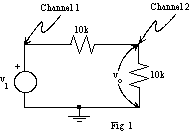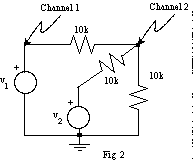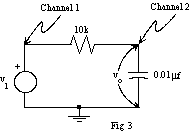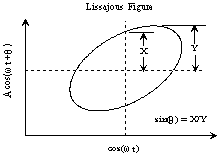EE 212 Lab
Lab 3: Sine Waves and the Oscilloscope
Prelab 3
The purpose of this lab is become acquainted with the operation of an
oscilloscope, function generator, and AC function of your multimeter
by investigating the sinusoidal responses of simple RC circuits.
Laboratory Procedure:
1. The Oscilloscope as a Voltmeter
Turn on the oscilloscope, display the trace for Channel (Ch) 1, and check trigger settings
(trigger menu => edge, rising (slope), CH1 (source), auto (mode), DC (coupling)).
Apply 0V then 5V to Ch 1 and compare the measured voltages
to multimeter readings. More accurate measurements may be obtained by using
cursors (cursor => voltage or time (type), CH1 or CH2 (source), then move vertical
or horizontal position knobs) or the measure mode
(top menu button followed by selecting time or voltage measurements).
2. Sine Waves on the Oscilloscope
a) Apply a small amplitude (less than 5V), 1kHz sine wave from your function generator
to Ch 1. Adjust the trigger controls to get a stable waveform display.
Experiment with the trigger level, slope, and other controls. Finish with
the display being triggered as the waveform crosses zero while rising.
b) Experiment with the time base control. Adjust the sine wave frequency
on the frequency generator to be exactly 1kHz. Use the cursors to measure
the period. What frequency is displayed on the oscilloscope? Is the reading
what you expect? Check the period of ten cycles.
c) Adjust the amplitude of the sine wave to be 1V peak-to-peak (p-p).
Measure the amplitude of the sine wave using the oscilloscope. What error
do you estimate for this amplitude measurement? Measure the amplitude with
the AC Volts function of the multimeter. How should and how do these numbers compare?
3. Voltage Divider and Superposition
a) Consider the circuit in figure 1.
- Wire up the circuit shown in figure 1 where v1 produces
a 5V p-p 1kHz sine wave.
- Display v1 on Ch 1 and output of this voltage divider, vo, on Ch 2.
Compare the voltages
and phases. Repeat at 10kHz.

b) Consider the circuit in figure 2 where a source and resistor have been
added to the circuit shown above in figure 1.
- Let v2 be a 5V DC source and use superposition to analytically
solve for the output voltage, vo (labeled Channel 2).
- Wire up the circuit shown in figure 2 with v2 a 5V DC source.
- Using the oscilloscope input select control, ground each
input to see where 0V DC is on the scope. Adjust the trace positions
so that 0V lies on the center graticule and measure vo. Is vo what you
expected it to be?
- Connect v2 to ground instead of 5V, and record
how the vo waveform changes. Reconnect v2 to 5V and
record the average value of vo as you slowly decrease v1
to 0V.
- Return v1 to a 5V p-p sine wave and AC couple the scope
inputs. Notice that the DC level is removed when the scope input is AC coupled. This is because a capacitor has been connected in series with
the input.

4. Phase Measurements
a) Consider the RC circuit shown in figure 3.
- Wire up the RC circuit shown in figure 3 with v1 a 1kHz 5V p-p sine wave.
- Observe the input v1 and output vo on the two
channels, and compare their amplitudes
and phases.
- Measure R with an ohmmeter, and calculate C from the ratio
of amplitudes and from the phase shift. Compare your calculated
values of C with the value labeled on the capacitor. Repeat at several
frequencies including 100Hz and 10kHz. At what frequency does the
measured value of C compare best with its labeled value ? What is
the maximum phase shift you can get?
- Use the XY mode of the oscilloscope (Display => XY (format)) to
display a Lissajous figure as shown in figure 4.
Determine the phase angle between v1 and vo from
this display.
 5. Summary
5. Summary
Before you go, make sure you understand the following concepts about
the oscilloscope:
-
Horizontal controls: Time per division, trigger level, trigger slope,
auto vs. normal sweep.
-
Vertical controls: Volts per division, fine vs. course scaling, AC vs. DC coupling.
-
XY Mode: Getting into and out of XY mode.
-
Measurements: Voltage measurement, phase measurement via time shift, phase measurement in XY mode using Lissajous
figure,
use of cursors.
-
Storage mode.

Fig. 4
© Copyright 2003 New Mexico Institute of Mining and Technology




